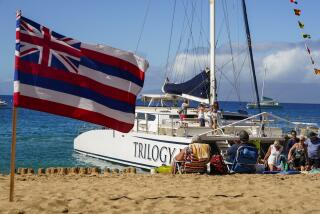A Visit to the Paradise of the Pacific
- Share via
The helicopter pilot’s name was Eric Lincoln, and he had been flying the wonderful bubble machines for 20 years. The heliport is tucked in behind the Maui airport about six minutes’ drive from Wailea.
I love helicopters because I get the wonderful feeling of free flight rather than being in the center of enough machinery to run a good-sized town.
Eric pushed and pulled some levers and buttons and the helicopter soared like a blue-and-white sea bird out over the ocean’s 100 shades of blue and turquoise and then drew a parabola over the mountains.
The mountains are 100 shades of green, some so pale they seem to be the color of pure light and some of them as dark as pine trees. There are streams, waterfalls, freshets and springs all over the hills, falling from 4 to 1,000 feet.
The hills are jeweled with flowering trees full of red and orange clusters. On this side of Maui, the area gets 408 inches of rain a year and the temperature is an average 80 degrees.
Eric said there are 21,000 kinds of orchids--and we must have seen most of them, even the shooting star which only grows in Hawaii.
We flew over the burial place of Charles Lindbergh at Kipahulu near a tiny red-roofed church. From the air, it is impossible to see how people crossed the spine of the mountains to build the church. We saw a macadamia orchard on the edge of a cliff that belongs to actor Jim Nabors. He calls it Gomer’s Pile.
Then Eric took us up to 9,500 feet as we flew over the edge of Mt. Haleakala, the world’s largest dormant volcano and Maui’s most mentioned landmark. The inside of the volcano is a tan and sandy silence, with two craters inside the huge hole.
On the other side of the crater, Maui is another world which gets an average of 10 inches of rainfall annually. Eric flew us over Hana, the oldest city in the islands. The area is now cattle country and it has been settled since about 600 A.D. The Polynesians crossed 3,000 miles of ocean in canoes between the 3rd and 6th centuries. They were, said Eric, the greatest navigators in the history.
According to Eric, Wailea has the finest diving spots in the islands. There are five crescent-shaped natural beaches with a great variety of fish and coral.
While we were on the wet side of the mountains, we flew through a shower of rain, like running through a lawn sprinkler on a summer afternoon, and then we looked down and saw a rainbow. It was like flying over a magical bridge.
On our last night on Maui, we had dinner at La Perouse, the much-honored upscale restaurant at the Wailea Intercontinental. It was a rich room that spoke of master chefs and pure elegance presented in the only way that counts, as if it didn’t, not really.
My friend Jean and I started with pheasant, orange and endive salad and progressed past a comforting soup. Then we were presented with fresh salmon with ginger, gilded in a mustard cream sauce.
By that time, we knew why all those awards were hanging in the foyer. Then came medallions of beef and mushrooms and a creme caramel for dessert. We made a sacred pledge never to eat again and we really didn’t until we had a cup of coffee on the plane.
The restaurant is named La Perouse after the French explorer who was the first European to map Maui in 1780. He named the bay next to Wailea, La Perouse Bay. I learned all that from Eric who is not only a fine pilot but a knowledgeable Maui guide.
It was a glorious week among easy people.
Driving in the upcountry one day, a gracious woman said to me, “How do you stand to live in California--all those earthquakes?”
You will be pleased to know that I did not point out that she lived on the side of a volcano. I know it’s dormant, and that’s what some said about Mt. St. Helen’s.
Ah well, it was all beautiful and living can be dangerous to your health. So enjoy.
More to Read
Sign up for The Wild
We’ll help you find the best places to hike, bike and run, as well as the perfect silent spots for meditation and yoga.
You may occasionally receive promotional content from the Los Angeles Times.






